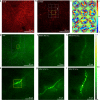Laser scanning reflection-matrix microscopy for aberration-free imaging through intact mouse skull
- PMID: 33184297
- PMCID: PMC7665219
- DOI: 10.1038/s41467-020-19550-x
Laser scanning reflection-matrix microscopy for aberration-free imaging through intact mouse skull
Abstract
A mouse skull is a barrier for high-resolution optical imaging because its thick and inhomogeneous internal structures induce complex aberrations varying drastically from position to position. Invasive procedures creating either thinned-skull or open-skull windows are often required for the microscopic imaging of brain tissues underneath. Here, we propose a label-free imaging modality termed laser scanning reflection-matrix microscopy for recording the amplitude and phase maps of reflected waves at non-confocal points as well as confocal points. The proposed method enables us to find and computationally correct up to 10,000 angular modes of aberrations varying at every 10 × 10 µm2 patch in the sample plane. We realized reflectance imaging of myelinated axons in vivo underneath an intact mouse skull, with an ideal diffraction-limited spatial resolution of 450 nm. Furthermore, we demonstrated through-skull two-photon fluorescence imaging of neuronal dendrites and their spines by physically correcting the aberrations identified from the reflection matrix.
Conflict of interest statement
The authors declare no competing interests.
Figures




Similar articles
-
Thinned-skull cranial window technique for long-term imaging of the cortex in live mice.Nat Protoc. 2010 Feb;5(2):201-8. doi: 10.1038/nprot.2009.222. Epub 2010 Jan 14. Nat Protoc. 2010. PMID: 20134419 Free PMC article.
-
Transmissive liquid-crystal device for correcting primary coma aberration and astigmatism in biospecimen in two-photon excitation laser scanning microscopy.J Biomed Opt. 2016 Dec 1;21(12):121503. doi: 10.1117/1.JBO.21.12.121503. J Biomed Opt. 2016. PMID: 27624000
-
Evaluation of cranial window types for in vivo two-photon imaging of brain microstructures.Microscopy (Oxf). 2014 Feb;63(1):53-63. doi: 10.1093/jmicro/dft043. Epub 2013 Nov 8. Microscopy (Oxf). 2014. PMID: 24212360
-
Anatomical and functional imaging of neurons using 2-photon laser scanning microscopy.J Neurosci Methods. 1994 Oct;54(2):151-62. doi: 10.1016/0165-0270(94)90189-9. J Neurosci Methods. 1994. PMID: 7869748 Review.
-
Imaging membrane potential in dendrites and axons of single neurons.Pflugers Arch. 2006 Dec;453(3):403-10. doi: 10.1007/s00424-006-0149-3. Epub 2006 Sep 26. Pflugers Arch. 2006. PMID: 17001494 Review.
Cited by
-
The ultra-thin, minimally invasive surface electrode array NeuroWeb for probing neural activity.Nat Commun. 2023 Nov 4;14(1):7088. doi: 10.1038/s41467-023-42860-9. Nat Commun. 2023. PMID: 37925553 Free PMC article.
-
Scattering correction through Fourier-domain intensity coupling in two-photon microscopy (2P-FOCUS).Photonics Res. 2025 Apr;13(4):845-864. doi: 10.1364/prj.544387. Epub 2025 Mar 11. Photonics Res. 2025. PMID: 40613029 Free PMC article.
-
Optical Imaging of Beta-Amyloid Plaques in Alzheimer's Disease.Biosensors (Basel). 2021 Jul 29;11(8):255. doi: 10.3390/bios11080255. Biosensors (Basel). 2021. PMID: 34436057 Free PMC article. Review.
-
Scattering Correction through Fourier-Domain Intensity Coupling in Two-Photon Microscopy (2P-FOCUS).ArXiv [Preprint]. 2025 Feb 10:arXiv:2401.15192v2. ArXiv. 2025. Update in: Photonics Res. 2025 Apr;13(4):845-864. doi: 10.1364/prj.544387. PMID: 39990789 Free PMC article. Updated. Preprint.
-
Harnessing forward multiple scattering for optical imaging deep inside an opaque medium.Nat Commun. 2024 Aug 27;15(1):7349. doi: 10.1038/s41467-024-51619-9. Nat Commun. 2024. PMID: 39187504 Free PMC article.
References
-
- Minsky, M. Microscopy apparatus. US Patent 3013467 Vol. 3013467 5 (1957).
-
- Dunsby C, French PMW. Techniques for depth-resolved imaging through turbid media including coherence-gated imaging. J. Phys. D. Appl. Phys. 2003;36:R207–R227. doi: 10.1088/0022-3727/36/14/201. - DOI
-
- Pawley, J. Handbook of Biological Confocal Microscopy (Springer, US, 2010).
-
- Booth MJ. Adaptive optical microscopy: the ongoing quest for a perfect image. Light Sci. Amp; Appl. 2014;3:e165. doi: 10.1038/lsa.2014.46. - DOI
Publication types
MeSH terms
LinkOut - more resources
Full Text Sources
Other Literature Sources
Molecular Biology Databases

